Preliminary Results of the Electrical Conductivity and Magnetic Nature of the Highly Pressed Double Halides of Mercury and their Equimolar Mixtures
Rabia Ahmad1 * , Jamshed Ali1 and Qamer Faisal1
1
Department of Chemistry,
Jamia Millia Islamia, (Central University), Jamia Nagar,
New Delhi,
110 025
India
DOI: http://dx.doi.org/10.12944/CWE.6.1.19
A preliminary report of some of the results of the measurements of the electrical conductivity of HgCl2, HgBr2, HgI2 and an equi-molar mixture of HgCl2 and HgBr2 and another of HgBr2 and HgI2, all these being pressed to 10 tons/cm2 of pressure, are reported. The very low value of the electrical conductivity of the two equimolar mixtures, compared to those of the corresponding double halides strongly suggests formation of some new product in both the cases. This is also supported by the X- ray diffractograms of the compounds. Finding the nature of the product is a matter for detailed study before any reliable conclusions can be drawn.
Copy the following to cite this article:
Ahmad R, Ali J, Faisal Q. Preliminary Results of the Electrical Conductivity and Magnetic Nature of the Highly Pressed Double Halides of Mercury and their Equimolar Mixtures. Curr World Environ 2011:6(1);135-139 DOI:http://dx.doi.org/10.12944/CWE.6.1.19
Copy the following to cite this URL:
Ahmad R, Ali J, Faisal Q. Preliminary Results of the Electrical Conductivity and Magnetic Nature of the Highly Pressed Double Halides of Mercury and their Equimolar Mixtures. Curr World Environ 2011:6(1);135-139. Available from: http://www.cwejournal.org?p=321/
Download article (pdf)
Citation Manager
Publish History
Select type of program for download
| Endnote EndNote format (Mac & Win) | |
| Reference Manager Ris format (Win only) | |
| Procite Ris format (Win only) | |
| Medlars Format | |
| RefWorks Format RefWorks format (Mac & Win) | |
| BibTex Format BibTex format (Mac & Win) |
Article Publishing History
| Received: | 2011-05-10 |
|---|---|
| Accepted: | 2011-06-13 |
Introduction
The electrical conductivity of molten mercury halides had earlier been studied.1 Some reactions can be cited where electrical conductivity had been studied during the reaction.2 Earlier electrical conductivity measurements have been done to show that the crystals prepared are of good crystalline quality.3 In the present work, the pellets of the double halides and their equimolar mixture are made from finely ground powders after putting them in a hydraulic press and applying pressure of 10 ton/cm2.The object is to measure the resistance and then from the thickness and the radius to get the electrical conductivity of each of the pellets. The very small value of the electrical conductivity of the equi-molar mixture of HgCl2 and HgBr2 as well as that of HgBr2 and HgI2, as compared to that of both the concerned double halides, suggests formation of a new product on application of the high pressure. However, knowing the nature of the new product is a matter for detailed investigation. Here, we report only the preliminary results of the electrical measurements and X-Ray diffractograms that support our contention. The conductivity is measured at the room temperature as well as at 70oC. We find a considerable fall in the conductivity at the higher temperature.
Experimental
The pellet is formed using an automatic hydraulic pellet press, fitted with a pressure gauge, showing the pressure on the scale. The pellet was made in a stainless steel die and no binder was used to bind the compounds. All the compounds used were of Merck Chemicals of 99.9 % purity. All the compounds were taken in same amount (3 gms.) for making their pellet. The pellet of the equimolar mixture was also made from 3 gms. of the mixture. The pellet formed was kept in a desiccator to prevent the moisture absorption.
Measurements of the Thickness and Radius of the Pellets
The thickness of the pellets formed was measured, using a traveling microscope of 0.01 mm least count. For this purpose, first, the traveling microscope was set at a lower curved edge of the pellet, and the reading (X) on the vernier scale of the microscope was noted. Then slowly and carefully, the microscope tube was shifted to the upper curved edge of the pellet and again reading (Y) on the vernier scale was noted. The thickness of the pellet measured is the difference of the two readings. Each measurement was repeated three times to minimize the errors.
The radius of the pellet was measured in a similar way as that of the thickness measurement, but in this case, the microscope was focused over the horizontal face of the pellet. Then first reading (P) at one edge of the pellet circumference was noted on the vernier scale, then microscope tube was shifted to the opposite edge of the pellet circumference, and again the reading (Q) was taken on the vernier scale. The diameter of the pellet is the difference of the two readings. The measurement was repeated three times.
Resistance Measurement at the Room Temperature
The pellets were pasted with silver paste on both sides, but not covering the curved sides. The silver paste makes the pellet surface conducting. Then the resistance of the pellets was measured using a digital electronic multimeter (Mastech MS8 200 G; ranges 200Ω to 20 MΩ, the accuracy being 99%). The instrument measures in six ranges, upto 200Ω, 2KΩ, 20KΩ, 200KΩ, 2MΩ and 20MΩ. First the instrument is set to a required range. The measured resistance is equal to the product of the reading with the maximum of the value of the range. Thus, when the reading is 0.8, and the maximum range of 20 MΩ is being used, the resistance being measured is 16 MΩ. In this particular range, the smallest difference of the resistance that can be measured is 0.2 MΩ. Each measurement was repeated three times to minimize the errors. Then conductivity of the pellets were calculated using the standard formula
K = d / RA
where K is the conductivity, R is the resistance, d is the thickness, and A is the area of cross section of the pellet.
The Results of Resistance Measurements at High Temperature (70oC)
The resistance of the pellets was also measured at high temperature (70oC). This was done by heating the pellet in the oven, set at 70oC, and quickly carrying out the resistance measurement. In this way, the mean temperature, during the experiment, would be a little lower than 70oC. However, this has been ignored. It was found that all of the compounds show very poor conductivity at the higher temperature.
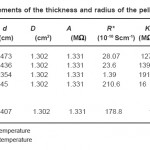 |
Table 1: Measurements of the thickness and radius of the pellets (10 ton /cm2) Click here to View table |
The Results of Magnetic Nature Determination of the Mercury Mixed and Binary Dihalides
It was found that, binary dihalides of mercury and their equimolar mixtures (HgCl2, HgBr2, HgI2, Equimolar mixture of HgCl2 & HgBr2, Equimolar mixture of HgBr2 & HgI2), at room temperature, are diamagnetic in nature. Solution of all of these compounds were prepared separately in ethanol and kept in a test tube. Then the solution was kept in a U shaped tube, fitted with a funnel at the top, between the poles of electromagnet attached with a constant current power supplier at 100 V potential differences and a current of 10 ampere. It was found that, level of the solution in the tube rises on applying magnetic field, which is the behavior of diamagnetic substances. This happened for all the samples.
Results and Discussion
Table 1 gives the measurements of the thickness, radius and the area of the pellets. The results of the electrical resistance measurement at the room temperature and at 70oC, electrical conductivity, as calculated from the data at room and at 70oC, are also shown in Table 1. For an equimolar mixture of two substances, one expects the conductivity of the mixture to lie in between the conductivities of the two substances. We find that in all the cases, the conductivity of both the equimolar mixtures is much lower than that of the two separate compounds HgCl2 and HgBr2 or HgBr2 and HgI2, as the case may be. This means that a new material is probably being formed which has extremely low conductivity, but this may not necessarily be a new chemical compound. Its identification and characterization is going to be a long drawn out affair.
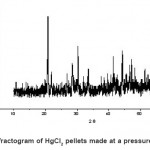 |
Figure 1: X- Ray diffractogram of HgCl2 pellets made at a pressure of 10 ton / cm2 Click here to View figure |
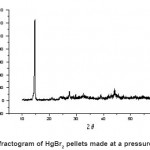 |
Figure 2: X- Ray diffractogram of HgBr2 pellets made at a pressure of 10 ton / cm2 Click here to View figure |
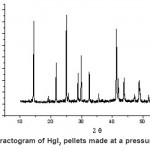 |
Figure 3: X- Ray diffractogram of HgI2 pellets made at a pressure of 10 ton / cm2 Click here to View figure |
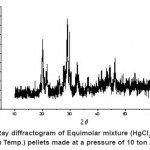 |
Figure 4: X- Ray diffractogram of Equimolar mixture (HgCl2 + HgBr2) (Room Temp.) pellets made at a pressure of 10 ton / cm2 Click here to View figure |
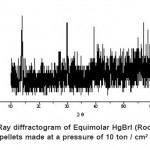 |
Figure 5: X- Ray diffractogram of Equimolar HgBrI (Room Temp.) pellets made at a pressure of 10 ton / cm2 Click here to View figure |
Fig. 1, 2 and 3 gives the X-Ray diffractogram of HgCl2, HgBr2 and HgI2 pressed at 10 ton pressure. Figures 4 and 5 give the X-Ray diffractogram of equimolar mixture of (HgCl2 + HgBr2) and (HgBr2 + HgI2) pressed at 10 ton pressure respectively taken by Rigaku X-ray diffractometer using Cu Ka radiation, voltage applying 40 kV at current 100 mA with step size 0.02, pattern from 100 to 600 (2θ).
Conclusion
On the basis of the sharp fall in the electrical conductivity of the compressed equimolar mixtures as compared to the conductivity of their component double halides, and the X-Ray diffractograms, it may be concluded that a new material, of extremely low conductivity, is produced. Pressure seems to have brought about production of the new material.
Acknowledgements
We are very thankful to Professor M.Z.R. Khan, Retd. Professor of physics, A.M.U., Aligarh, for several discussions, which have proved extremely useful to us. Thanks are also due to Professor Mushahid Hussain, Professor of Physics, J.M.I, for helpful suggestions.
Authors are also thankful to Prof. Ajay Gupta, Centre Director of IUC-DAE-CSR, and Dr. R. J. Choudhary, Scientist of the UGC-DAE-CSR, Indore. Special thanks are due to the Ex-Head of the Department Prof. Kishwer Saleem for extending to us the facilities of the department. We are also thankful to Prof. Sharif Ahmad, H.O.D., Department of Chemistry, Jamia Millia Islamia, New Delhi.
References
- Cleaver, B. and Smedley S. I., Trans. Faraday Soc., 67: 1115 (1971).
- Beg, S. and Ahmad A., J. Solid Stat. Chem., 105: 130 (1993).
- Manoel, E.R., Custodio M.C.C., Guimaraes F.E.G., Bianchi R.F. and Hernandes A.C.,Mater. Research, 2 (1999).






